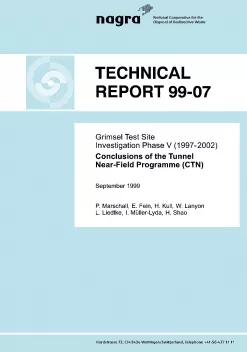
Technical Report NTB 99-07
Grimsel Test SiteInvestigation Phase V (1997 – 2002):Conclusions of the Tunnel Near-Field Programme (CTN)
The project "Conclusions of the Tunnel Near-Field Programme" provides a synthesis of the achievements of the "Tunnel Near-Field Programme" of the GTS Investigation Phase IV (1994 - 1996). The synthesis is aimed, in the light of performance assessment requirements, at deriving a state-of-the-art approach for geoscientific characterisation and conceptualisation of the zone of rock around tunnels and caverns of a radioactive waste repository. The impact of the tunnel near-field on repository performance depends strongly on the type of host rock being assessed. The investigations addressed in this report are largely based on experience from the Grimsel Test Site and, therefore, are representative for crystalline rock or - in a broader sense - for fractured hard rock formations. Particular emphasis is given to the following issues:
- What is the role of the tunnel near-field in the assessment of repository performance? The particular processes addressed are migration of waste-generated gas, resaturation of the tunnel near-field after repository closure and the effect of the excavation disturbed zone on groundwater flow.
- How to convert geoscientific field data into valuable deliverables for performance assessment? A systematic and traceable approach is proposed, aimed at identification of the key processes of the synthesis procedure and at definition of a data exchange format adapted to the needs of performance assessment.
- With the focus on tunnel near-field characterisation, what are the determining factors in planning an underground site exploration programme? The choice of the site characterisation technique for a given exploration programme must respect the geological conditions as well as economic and time constraints. This report gives an overview of suitable exploration methods with special focus on equipment development within the framework of the Tunnel Near-Field Programme.
- How to establish quantitative models for gas migration and post-closure repository resaturation? For modelling two-phase flow processes in fractured hard rock, equivalent porous medium approaches have been shown to be an appropriate conceptualisation. Parametric models of capillary pressure and relative permeability, as well as two-phase flow parameter values, are compiled for matrix zones and shear zones of the GTS. An upscaling procedure for two-phase flow parameters is proposed, which respects the complexity of the fracture systems in a fractured hard rock. Finally, experimental evidence is given for the evolution of an unsaturated zone around underground excavations. The relevance of the unsaturated zone in terms of repository performance is assessed by numerical scoping calculations.
- How to establish quantitative models for estimating axial flow along sealed tunnel sections and how to estimate groundwater flow enhancement along emplacement caverns? Based on the fracture network approach, a conceptualisation of the excavation disturbed zone around underground openings is given. The hydraulic properties of the EDZ around TBM drilled and blasted tunnel sections at the GTS are compiled. Finally, a conceptual framework for estimation of axial flow around seal zones is given. A numerical sensitivity study of axial flow with generic field data is presented.
Complementary to the investigations at the GTS, this report presents a survey of tunnel near-field studies in other hard rock laboratories worldwide and a review of numerical tools for modelling groundwater flow and two-phase flow processes in the tunnel near-field.
